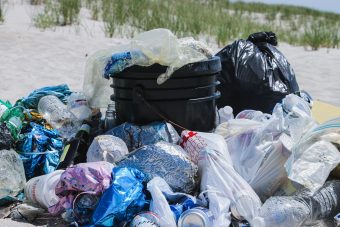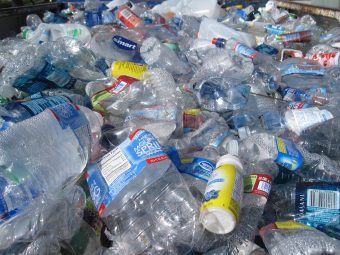
At the recent United Nations Ocean Conference, another 22 governments agreed to join the New Plastics Economy Global Commitment, which unites stakeholders around the goal of transitioning towards a circular economy for plastic.
Co-led by the UN Environment Programme (UNEP) and the Ellen MacArthur Foundation, the global commitment has over 500 signatories across businesses, governments and other organizations committed to ensuring that plastic never becomes waste.
Plastic production, use and disposal are all contributors to the triple planetary crisis. UNEP’s From Pollution to Solution report shows that some 400 million tonnes of plastic is produced annually, and 7 billion tonnes of all plastic manufactured between 1950 and 2017 has become waste.
The equivalent of a garbage truck of plastic is dumped into the ocean every minute, threatening biodiversity and damaging marine ecosystems, while greenhouse gas emissions associated with plastics are expected to reach 6.5 gigatons by 2050.
More:
“Plastic pollution is a global crisis that threatens the environment, human health and the economy,” says Sheila Aggarwal-Khan, Director of the Economy Division at UNEP
“It is critical that we transition towards a circular approach that considers the plastics’ full life cycle – from the extraction of raw materials to end-of-life management – to minimize their impact on the planet.”

Here’s what you need to know about the life-cycle approach to plastic pollution, the benefits of circularity and how it can help stave off this global crisis:
A life-cycle approach is a way of thinking that considers the impacts of all the stages of a product or service’s life cycle. This approach helps us recognize how our choices are part of a wider and interconnected system.
UNEP’s Life Cycle Initiative, a multi-stakeholder partnership that enables the global use of credible life cycle knowledge, identifies these stages as raw material extraction, design, production, distribution, use, recovery and disposal. The recovery stage includes recycling materials and reusing products, which are necessary steps to create a circular model where resources do not become waste.
Research shows that a shift to a circular economy can reduce the volume of plastics entering the ocean by over 80 percent and save governments USD 70 billion by 2040. It can also reduce greenhouse gas emissions by 25 percent and create 700,000 additional jobs.
Why is it important to adopt this approach?
A life-cycle approach allows people to make informed decisions that protect human and environmental health. Each life cycle stage offers the potential to reduce resource consumption and improve the performance of products to ensure collective responsibility across all stages of a product’s life cycle, thereby helping to design practical actions to tackle pollution. It evolves from the traditional focus of production, use, and disposal by highlighting the environmental, social, and economic impacts over the entire life cycle of products. A life-cycle approach also ensures that improvements in one life-cycle stage do not inadvertently create trade-offs in other stages.
How does this approach work with plastics?
A life-cycle approach to plastics considers the impacts of all activities and outcomes associated with producing and consuming plastic materials, products, and services.
This approach is key to enabling the global systemic change and collaboration that experts say are needed to curb plastic pollution. Using a life-cycle approach, we can identify the changes needed across all stages of a product’s life cycle to reduce the ubiquity of plastic pollution.
What actions can we take?
Products should be designed to be reused, recycled, and made with recycled content to limit the presence of plastics in the environment as much as possible.

Businesses can practice corporate responsibility by avoiding energy-intensive processes and switching to renewable energy. Plastics should also be free of hazardous chemicals.
Consumers can opt for reusable products to be used and reused as much as possible, ensuring they are efficiently washed and demanding that they are properly recycled. They can also play an important role in boycotting certain plastic products and advocating for businesses and governments to take stricter action on plastic use.
Governments need to be involved across all stages of plastic products’ life cycle and take actions to move to a new plastics economy, to eliminate, innovate and circulate. These include incentivizing reuse, banning unnecessary plastic packaging and products, investing in recycling infrastructure, and committing to partnerships that tackle existing plastic pollution. Raising awareness and promoting circularity can also be impactful.
What progress has been made towards adopting a circular economy for plastic?
In addition to the Global Commitment, world leaders agreed on a historic resolution to forge a legally binding agreement to end plastic pollution by 2024 at the resumed fifth session of the UN Environment Assembly in March.
The resolution addressed the full life cycle of plastic and established an Intergovernmental Negotiating Committee (INC). The first INC meeting, to be held in Uruguay from 28 November to 2 December 2022, will see countries begin the process of negotiating the agreement.
In conjunction with the meeting, UNEP will host a multi-stakeholder forum on 26 November to provide a platform for all stakeholders to provide input to the negotiations.
“The linear plastic economy is at the basis of the plastic pollution crisis,” says Aggarwal-Khan. “While the best solution differs by region, ultimately, following a life-cycle approach can set us on the path to circularity and combating the scourge of plastic pollution; additionally, a circular system change scenario will generate more and better jobs and bring significant economic savings.”
Pollution & Waste
To fight the pervasive impact of pollution on society, UNEP launched #BeatPollution, a strategy for rapid, large-scale and coordinated action against air, land and water pollution. The strategy highlights the impact of pollution on climate change, nature and biodiversity loss, and human health. Through science-based messaging, the campaign showcases how transitioning to a pollution-free planet is vital for future generations.
Source: UNEP



